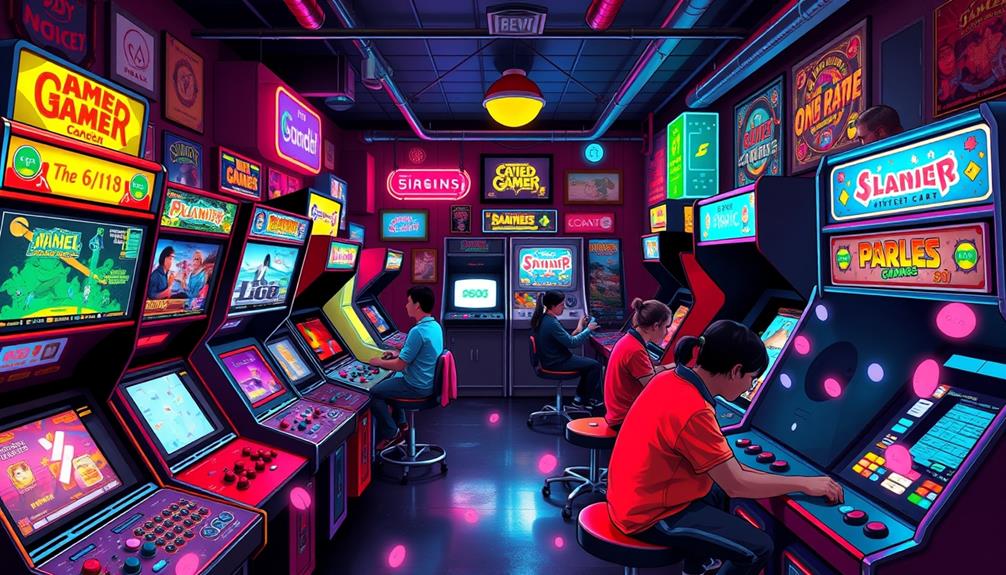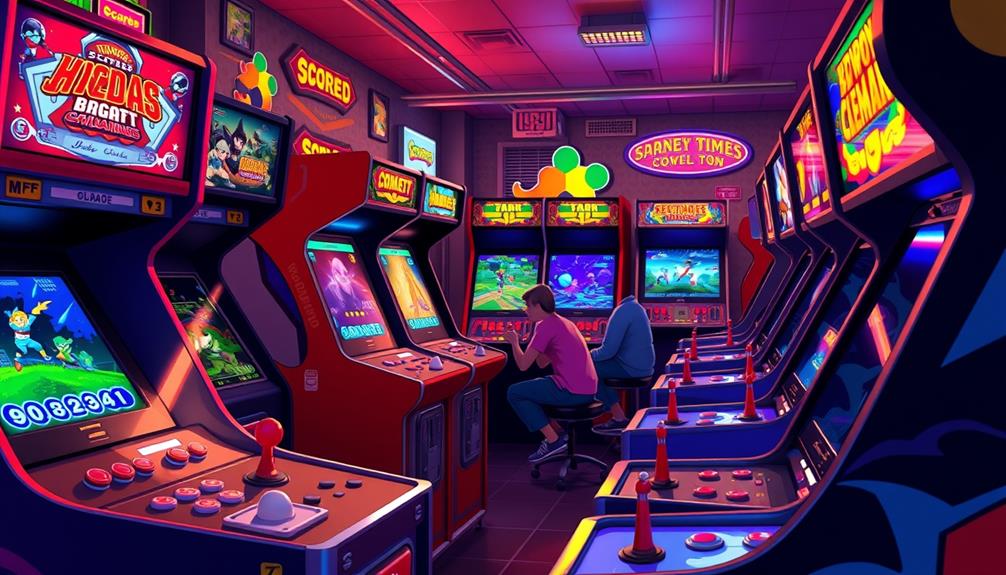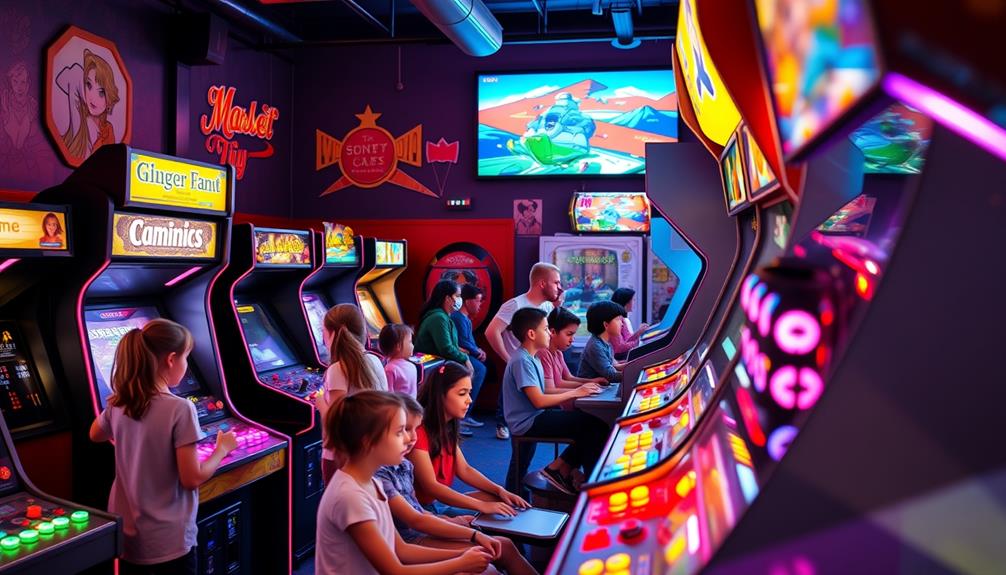Yes, arcade games are indeed categorized as video games. They involve user interaction through a user interface and provide visual feedback, similar to other video games. Typically, arcade games are coin-operated, designed for short play sessions, and encourage community engagement. Classics like Pac-Man and Donkey Kong showcase their popularity and influence. These games not only revolutionized game design but also became cultural symbols in the 1980s, significantly contributing to the gaming industry. If you’re interested in comparing arcade games to console games and exploring their lasting impact, there is much to discover! Looking forward, upcoming arcade game trends are centered around integrating advanced technology and innovative gameplay mechanics. With the growing popularity of virtual reality and augmented reality, arcade games are evolving to provide immersive experiences that surpass traditional 2D gaming. Moreover, there is an increasing focus on multiplayer interaction and competitive gaming in arcade environments, creating a lively and social atmosphere for players. As the gaming industry progresses, arcade games continue to play a significant and thrilling role in the gaming world.
Key Takeaways
- Arcade games are a specific format of video games, designed for user interaction and visual feedback on display devices.
- They involve electronic gameplay, which is a fundamental characteristic of all video games.
- Arcade games often feature short play sessions and simple control schemes, emphasizing replayability and improvement.
- The historical context shows that arcade games significantly contributed to the evolution of video gaming since the 1970s.
- Cultural impact and community engagement are key elements that define arcade games as a vital part of the video game ecosystem.
Definition of Video Games
When you think of video games, you're likely picturing interactive experiences that engage players through visual feedback on screens. Video games are defined as electronic games that involve interaction with a user interface, generating visuals on two- or three-dimensional display devices.
This classification encompasses various formats, including arcade games, which are typically coin-operated and designed for public play. Unlike home console games, arcade games provide an immediate and communal gaming experience. Additionally, many of the best arcade machines for home game rooms reflect the timeless appeal of these games, combining classic designs with modern technology integration for an enhanced experience best arcade machines.
Arcade games often feature fast-paced, skill-based gameplay that keeps players coming back for more. They include a range of genres, from action to adventure, and have a unique charm rooted in their interactive digital nature. Since their emergence in the 1970s, arcade games have evolved alongside home gaming systems, but their core essence remains intact.
The International Game Developers Association (IGDA) recognizes the significance of arcade games, highlighting their cultural and economic impact within the broader video game industry.
Characteristics of Arcade Games

Emphasizing quick, engaging gameplay, arcade games stand out as a unique subset of video games designed for public enjoyment.
These coin-operated machines deliver an immersive experience through straightforward game mechanics that prioritize fun and skill. Many arcade games also draw inspiration from classic and modern pinball machines, which have been known for their exciting and replayable nature, as seen in best rated pinball machines.
Here are three key characteristics that define arcade games:
- Short Play Sessions: Levels are structured as quick bursts, allowing you to jump in and out, perfect for when you're on the go.
- Increasing Difficulty: As you progress, the challenges ramp up, keeping you on your toes and pushing you to improve your high score.
- Simple Control Schemes: The control methods are typically easy to master, making it accessible for players of all skill levels, unlike complex gameplay found in many modern titles.
Classic arcade games like Pac-Man and Donkey Kong exemplify these traits, showcasing fast-paced action video elements that encourage repeated attempts.
The thrill of beating your previous score or advancing further keeps players engaged.
These defining characteristics highlight why arcade games have maintained their popularity and influence on modern gaming, despite their simplicity compared to more intricate game mechanics.
Historical Context of Arcade Games

Arcade games transformed game design by introducing new mechanics and engaging gameplay that captivated players.
The evolution of arcade games can be paralleled with the rise of community-oriented experiences in celebrity culture, where shared interests bring people together, much like how Kourtney Kardashian's nude photo scandal impacted her reputation.
Technological advancements allowed for more complex and immersive experiences, shaping how games were created and played.
As these games gained popularity, they also influenced culture, reflecting societal trends and creating a communal atmosphere in gaming.
Evolution of Game Design
The evolution of game design, particularly in the domain of arcade games, traces a fascinating journey that began in the 1970s. It all kicked off with the release of *Pong* in 1972, marking the inception of commercial arcade video gaming.
This led to a booming arcade industry, especially during the golden age of arcade games in the 1980s. Iconic titles like *Pac-Man* and *Space Invaders* not only popularized the format but also established a vibrant arcade culture.
As gaming has evolved, we see parallels in modern trends like Nike Tech in Sneaker Culture 2024, which merges innovation and style to appeal to consumers.
As you explore this evolution, consider three pivotal changes that shaped arcade games:
- Programmable Microprocessors: These allowed for more complex gameplay mechanics, enhancing player engagement.
- 3D Graphics and Motion Simulation: Technological advancements in the early 1990s pushed the boundaries of design, creating immersive experiences.
- Adaptation to Home Consoles: The rise of home consoles influenced arcade games, prompting adaptations that incorporated new gaming innovations to stay relevant.
Understanding this evolution reveals how arcade games have continuously adapted, ensuring their place in the broader landscape of video games.
Technological Advancements Impact
Technological advancements have played a crucial role in shaping the historical context of arcade games. You can trace the evolution of video games back to the 1970s when titles like "Pong" marked the beginning of this new cultural phenomenon. The introduction of programmable microprocessors in 1975, highlighted by games like "Gun Fight," allowed developers to create more complex arcade video games, paving the way for the Golden Age.
This era peaked with the release of "Space Invaders" in 1978, which helped the gaming industry reach an impressive $8 billion valuation by 1981. Additionally, the integration of high-quality content into gaming narratives and mechanics enhanced player engagement and retention, further shaping the gaming landscape.
As home consoles rose in popularity, the gaming experience of arcade games had to adapt. The early 1990s brought technological advancements like improved graphics and gameplay, ensuring that arcades remained relevant.
Innovations, including motion simulators and advanced audio-visual effects, further enhanced the arcade gaming experience during the recovery phase in the late 1980s and early 1990s. These advancements not only kept arcade games competitive but also solidified their place as a significant aspect of video game history, showcasing the dynamic relationship between technology and gaming.
Cultural Influence on Gameplay
If you think back to the 1980s and 1990s, you'll likely recall the vibrant atmosphere of arcades filled with the sounds of beeping machines and excited players.
These arcade games became cultural phenomena that shaped gaming experiences during that era, much like how astrology influences attractiveness in social settings. They fostered social interactions, where players gathered to compete and share strategies.
Consider these iconic elements of arcade culture:
- The clattering of coins as they dropped into machines, signaling the start of a new gaming session.
- The cheers and groans of players as they battled in games like Street Fighter or Pac-Man.
- The community vibe that emerged around high scores, with players forming bonds over shared victories and defeats.
The arcade video game industry thrived, reaching a valuation of $8 billion by 1981, thanks to these engaging experiences. This explosive growth was driven by the widespread appeal of iconic games like Pac-Man and Space Invaders, which captivated players across generations. Game developers and arcade operators quickly recognized the lucrative potential of the industry, sparking innovation and competition. As a result, the question “are arcade games profitable?” was met with a resounding yes during this golden era, as the sector became a cornerstone of entertainment culture.
As nostalgia for these classic arcade games resurfaces, adult-oriented arcades have emerged, inviting former players back for social gameplay.
This blend of gaming and community emphasizes how arcade games not only provided entertainment but also shaped social dynamics and cultural identity in the world of video games.
Game Mechanics and Dynamics

Arcade games captivate players with their straightforward mechanics and dynamic gameplay. These games often feature simple control schemes that prioritize twitch-style gaming, relying on your quick reflexes and precise timing. The gameplay loops are designed for rapid sessions, with discrete levels that encourage you to jump back in after a coin drop, making it easy to retry when you fail.
Additionally, unique party options can enhance the atmosphere around arcade game gatherings, making them a fun social experience.
A defining characteristic of arcade machines is the lives system, which lets you continue the game by inserting additional coins when you run out of lives. This system enhances the competitive nature of arcade action, as you aim to improve your skills with each attempt. As you play, you'll notice that difficulty escalates quickly, keeping you engaged and challenged, which is a key aspect of their addictive nature.
Arcade games focus on immediate fun and skill improvement rather than complex narratives or loot systems. The mechanics encourage you to master each level, ensuring that the excitement never wanes.
Differences Between Arcade and Console Games

When you think about gameplay mechanics, arcade games often offer quick, intense challenges, while console games provide deeper narratives and progression.
The design of arcade games typically emphasizes immediate gratification and skill mastery, making them ideal for short bursts of fun, similar to how best vacuums for dust removal are designed for effective and efficient cleaning.
You'll notice that social interaction also differs; arcade games thrive on local multiplayer and competition for high scores, whereas console games might focus on cooperative experiences or online play.
Understanding these differences can help you appreciate what each platform brings to the gaming world.
Gameplay Mechanics Comparison
The heart of gameplay mechanics in arcade and console games reveals distinct approaches that cater to different player experiences. Arcade games focus on fast-paced, twitch-style gameplay, making them ideal for quick bursts of fun, while console games often engage with complex narratives and longer play sessions that require more strategic thinking. This dynamic is similar to the importance of balancing creativity and structured approaches as emphasized in nurturing an imaginative mindset.
Here's how they differ:
- Control Schemes: Arcade versions usually utilize simplified controls, like a joystick and a few buttons, making it easy to jump in and start playing. In contrast, console games employ intricate controls to navigate expansive worlds.
- Difficulty Levels: In arcade games, difficulty escalates rapidly, challenging your reflexes and keeping you engaged. Console games, however, may offer adjustable difficulty or a gradual increase in challenge, allowing for a more tailored experience.
- Lives System: Arcade games often incorporate a lives system, where you keep inserting coins to continue after failure. Console games typically feature save points or checkpoints, enabling longer-term gameplay continuity.
These gameplay mechanics highlight how arcade games deliver quick thrills through short sessions, while console games provide a more immersive experience that encourages exploration and progression.
Social Interaction Dynamics
In today's gaming landscape, social interaction plays an essential role in how players experience both arcade and console games. Arcade games are typically designed to foster community engagement, featuring local multiplayer options that encourage competitive play among friends. You might find yourself gathered around a machine in a traditional arcade, cheering each other on as you vie for high score tracking.
This physical presence creates shared experiences that console games often lack, as they tend to prioritize solo gameplay or online interactions. Additionally, the quick play sessions of arcade games can resemble the engaging nature of various brewing methods that bring people together over a cup of coffee.
Arcade games promote quick play sessions with escalating difficulty, allowing multiple players to jump in and out seamlessly. This contrasts with the lengthy, narrative-driven campaigns of many console games, which can lead to a more isolated experience at home.
The nostalgic aesthetic and sound design of classic arcade titles enhance the social atmosphere, making it easy to bond over familiar gameplay. While console games may offer online rankings and achievements, they often miss the vibrant community spirit found in arcades.
Ultimately, the social interaction dynamics in arcade games provide a uniquely engaging experience that keeps players connected.
Cultural Impact of Arcade Games

Arcade games revolutionized the gaming landscape and left an indelible mark on pop culture during the 1980s. They became a cultural phenomenon, influencing everything from fashion to music. Titles like Space Invaders and Pac-Man weren't just games; they became iconic symbols of the era, creating a sense of nostalgia that still resonates today.
Here are three key impacts of arcade games:
- Social Interaction: Arcades fostered a community, where friends and strangers bonded over competitive games like Street Fighter II.
- Economic Impact: By 1981, the arcade video game industry was valued at a staggering $8 billion in the US.
- Gaming Discussions: Classic titles continue to inspire modern games, with developers drawing on their gameplay mechanics and aesthetics.
Even as arcade popularity waned in the late 1990s, nostalgia-driven venues emerged, reviving interest in these traditional experiences.
The cultural significance of arcade games remains evident, as they continue to spark gaming discussions and influence new generations of players. Their legacy endures, reminding you of the joy and camaraderie found in those buzzing arcade halls.
Future of Arcade Gaming

Nostalgia is driving a vibrant revival in arcade gaming, as players seek out familiar experiences that blend classic gameplay with modern flair.
Barcades are at the forefront of this movement, merging adult-oriented social environments with beloved arcade games. You can sip on a drink while reliving the excitement of your youth, making it a unique outing.
Technological advancements are reshaping the arcade landscape, with companies like Raw Thrills and LAI Games creating new titles that incorporate modern gaming technologies while keeping the essence of traditional gameplay.
Competitive gaming events are revitalizing arcade-style play, letting you engage in high-stakes tournaments that echo the golden age of arcades.
The COVID-19 pandemic hit arcades hard, leading to closures and a need for innovation to attract players back.
Future developments may include adaptive difficulty levels in hyper-casual games and the integration of facial recognition technology to enhance player experiences.
These changes promise to make arcade gaming more engaging and accessible than ever.
As you explore these evolving spaces, the blend of nostalgia and innovation will redefine what it means to play arcade games in the future.
Frequently Asked Questions
Do Arcade Games Count as Video Games?
Sure, arcade games definitely count as video games. They offer interactive experiences, featuring engaging gameplay and electronic elements. You'll find their simple controls and fast-paced action appealing, just like any other type of video game.
Is Arcade a Video Game?
When you think of classic gaming, can you imagine the thrill of feeding quarters into a cabinet? Yes, arcade games are indeed video games, offering fast-paced fun and skill challenges that keep players coming back for more.
What Are Considered as Video Games?
Video games include any electronic games you interact with through a user interface that produces visual feedback. This encompasses various formats, from home consoles to mobile devices, emphasizing gameplay and interactivity regardless of the platform.
What Are the Classification of Arcade Games?
Imagine stepping into a buzzing arcade, where you'll find electro-mechanical games, pinball machines, and redemption games. Each classification offers something unique, ensuring excitement and challenge as you navigate through nostalgic gameplay experiences.
Conclusion
In the grand tapestry of gaming, arcade games undeniably weave themselves into the fabric of video games. With their unique characteristics, historical significance, and cultural impact, they've carved out a niche that's both vibrant and essential. While they differ from console games in mechanics and dynamics, their charm continues to captivate players. So, whether you're chasing high scores or reliving nostalgia, remember: arcade games are not just part of the video game world; they're a cornerstone of it.









